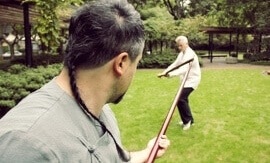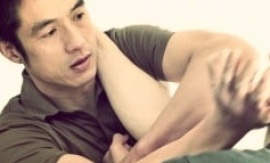
WING CHUN IS MEANT TO BE A VERY EFFECTIVE TOOL, USED TO DEFEAT AN ENEMY IN THE SHORTEST POSSIBLE TIME. AGE, GENDER, OR EVEN EXTREME PHYSICAL IMPAIRMENTS DO NOT MATTER, WHETHER A WING CHUN PRACTITIONER IS DEALING WITH ONE OR SEVERAL OPPONENTS AT A TIME.
These unique characteristics of the system are often used to capture potential students’ attention. Unfortunately, sometimes, reality hits you faster than you may have been taught it will!
Speed, timing, striking distance and accuracy are skills that allow one to be able to fight any opponent, but it all becomes useless if you do not have sufficient punching power to effectively stop an aggressor. Take a moment to visualise yourself in a situation, where blows are being exchanged, both in striking range; in such a situation, a lack of punching power would most likely have fatal consequences.
Physical differences, due to genetic gender specifications, can be a drawback when trying to develop punching power; thus, it can become even more difficult for a woman to compete against a man. So, how do you generate knockout power? Various methods are being used by martial artists to improve power; some include lifting weights or equipment training of all kinds, which usually focus on strengthening isolated muscle groups. Because of this, the total proportion of trained muscle mass is relatively low.
To generate punching power, you need to create a structure, which utilises the whole body as a unit and aligns all the muscles in the direction of the punch. For people with a small frame physique, this is mandatory. When I first met my Sifu, the late Wong Shun Leung, I was puzzled how such a small person, who weighed less than 70kgs, could generate such incredible power with which he was able to catapult people, who weighted significantly more than him, without any visible effort. This was something that no one was able to do to him! Through training, it became apparent to me there were no tricks. It was simply a matter of the intelligent training methods of the Wing Chun system.
Let me ask you a question that is crucial in understanding the development of power: What is the reason behind this rather uncomfortable training stance, Yi Ji Kim Yeung Ma, where the feet are turned slightly inwardly? Over the past three decades, I have heard countless different answers to this question that have all pretty much proved to be nonsense; from the “strengthening of the legs”, to the “rooting to the ground”, to “creating faster pace”, I never got a plausible explanation about the mechanisms behind this stance.
The most significant factor influencing the development of power is the very quick rotation of the body axis, more specifically, the rotation of the vertebral column. We first start to train this in the Cham Kiu form by executing 180 degrees rotations with both arms fixed in the Lan Sau position in order to synchronise the elbow with the hip. This action is only possible when the feet completely support the rotation; that is, the respective “rear foot” turns enough as to not slow down or shorten the distance of the rotation of the hip. In order for 100% of the rotational energy to be delivered via the elbow to the target, the hip and elbow must be completely synchronised; without this synchronisation, only the isolated strength of the arms is involved in the punch!
As humans, we do not normally walk around with our feet pointing inwards; instead, they tend to point slightly outwards. This is a 24-hour behaviour, which counteracts the feet position needed in order to apply the hips. To create the required structure involves nothing more than conditioning the feet, so the power development is not hindered. Standing in the Yi Ji Kim Yeung Ma stance on your very first day of Wing Chun training, simply means you begin working on the behaviour needed to support your punch.
In my classes, I begin teaching Poon Sau before the Cham Kiu form. The Poon Sau exercise is performed in the static Yi Ji Kim Yeung Ma stance without any body-rotation and allows for an exchange of power between both practitioners. The Taan Sau and Fook Sau movements are perfectly suitable to train the specific Wing Chun punch. Both these movements keep the elbow low and aligned to the centre of the body, which allows the practitioners to exchange power perfectly, developing the muscles needed to support the punch. Because of the posture, the energy flows towards the direction of the legs and down into the feet, which helps the feet to adapt this inwards position much quicker.
During each rotation in Poon Sau, the practitioner should be “feeling” the flow of the power from the elbow to the hip to the legs and, finally, to the feet. If this does not happen correctly, it will lead to the use of the upper body to resist the partner’s energy, which will isolate the lower part of the body. The goal is to be able to resist any incoming power without losing balance. Now that the source of energy has been established, and you have learned to work with the source, you can begin to train your punch on the wall bag without risking the use of only upper body strength.
This leads us to the next step in developing punching power, which is the partner drill, known as Sheung Ma/Tui Ma. From Poon Sau rolling, one of the partners initiates an “attack” by stepping forward while changing the Bong Sau to Taan Sau, which forces the other partner to use Fook Sau to nullify the “attack”. This can be repeated again and again, either returning back to rolling, or they can do several “attacks” in succession, before returning to Poon Sau rolling and start over again.
The Sheung Ma/Tui Ma drill was trained for countless hours during my time in Hong Kong, to the point where I thought it was the only exercise that existed in Wing Chun! If you consider the fact that I have trained privately with my students (most of them were heavier than me!) sometimes for five hours a day, and during each hour, I was pushing each student backwards around 300 times while the student was pushing towards me, you can understand the amount of energy I have invested in my punch.
So, with each rotation of the arms during Poon Sau, and in each step you take, forward or backwards, you are training your punch using the whole body and making your steps faster and more efficient, because you are developing functional power. You should spend most of your time developing your punching power, instead of “rolling” and focusing on feeling and fishing arms. It is worth mentioning that during my time in Hong Kong, I mostly saw the Sheung Ma/Tui Ma drill being trained in Sifu Wong Shun Leung’s school and, likewise, in Sifu Ho Kam Ming’s school in Macao.
After the Cham Kiu form has been perfected, it is time for the student to learn the Muk Yan Jong form. The Wooden Dummy is an important tool to develop punching power, as the angle of the upper arms is designed perfectly for using our elbows. The Muk Yan Jong form teaches one coordination and synchronisation where body rotations coordinated with steps and arm movements are performed in order to learn to use the whole body to deploy maximum punching power. However, be careful; too often, I see practitioners do the exact opposite—countless, uncoordinated actions at high speed without the support of the whole body; losing synchronisation happens very fast and makes the training process counter-productive, leading to the punching power to fade quickly.
The biggest mistake a practitioner can do is to try to interpret the forms or even Chi Sau into applications. Most of the movements are not directly applicable and are meant to guide the practitioner in developing a particular skill, like simultaneous arm movements, maintaining the vertical axes, and correcting errors or the development of the punch. One could say that Wing Chun is a method to develop the main weapon, your punch, and neglecting it would turn Wing Chun into the worst martial art in existence.
For Part 2, go here.



















